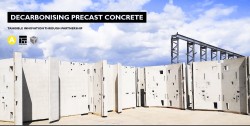Following on from last issue, the Decarbonising Precast Concrete programme has now published its report on the UK team developing processes to achieve 40% reduction in embodied carbon emissions from precast concrete across construction.
The pilot, funded by Innovate UK’s Sustainable Innovation Fund and supported by Ministry of Justice’s (MOJ) future capital programmes, has developed an optimised design and mix technical specification that delivers a net reduction of 40% in structural precast concrete’s embodied carbon emissions when benchmarked against the ICE database.
The significant carbon reduction from the baseline figure provides a solution that is a technically ready and commercially viable in both price and risk, that can be applied across the construction supply chain, as well as a meaningful new starting point for future embodied carbon reductions within the precast industry.
Precast concrete is one of the most widely adopted modern methods of construction, with the UK’s precast concrete sector forecast to grow by 18% to £2.3billion by 2024. Its fuel and carbon intensiveness will prove problematic for many designers and specifiers of new buildings, as whole-life emissions calculations become more intrinsic to the UK’s built environment.
Focused research and innovation is therefore essential to ensure viable alternatives are conceived, tested and scaled in order to deliver planned infrastructure in a way that does not compromise the UK’s clean growth strategy. “This study demonstrates how collaboration through the supply chain can bring subject matter experts together to develop innovative solutions for decarbonising,” says Gareth Jones, Head of MMC & Technical Services, Ministry of Justice. “We look forward to utilising and embedding such solutions in the Ministry of Justice’s New Prison Programme.’’
The Decarbonising Precast Concrete (DPC) project brought together design-for-manufacture experts Akerlof, materials manufacturer Forterra, and façade construction specialist PCE, along with 30 other expert contributors, to examine every decision in the traditional method of building with precast materials through the lens of carbon and develop a new, whole-process approach.
“Our sector’s pathway relies on a holistic approach to new buildings,” says John Handscomb, Founding Partner, Akerlof. “Combining intelligent design that minimises material use without affecting a structure’s integrity with an understanding of construction, transport and installation emissions. Importantly, suggested solutions must be commercially viable. Innovation even on a seemingly small scale has to be supported and encouraged to help us move along the roadmap to our biggest goal – net zero carbon construction.”
Today, due to the risk management and commercial agreements in place in supply chains for projects, a traditional approach to carbon reduction is sub-optimal – it happens only within its constituent parts, rather than collaboratively, allowing iterative learning. Taking a holistic approach, the DPC team started with operational activity mapping to create detailed measurements of all partners’ activities, used benchmarking calculations to identify carbon quantums in the structure, then optioneered and optimised different solutions for each stage – design (including geometry, loading, strength and working life analyses), manufacturing mix, and install – at all times within commercial and design code constraints.
The improvements made at each stage of our journey to carbon reduction are cumulative, with a net saving of 40% from the baseline ICE database scenario of 779,156kgCO2e per houseblock.
By collaborating across the entire built environment value chain and calibrating current industry practises the DPC team have delivered an optimal carbon solution to the industry that is now well placed to become a base case for future innovation to reach the UKs net zero targets. The project outcomes are intended to be transferable to other sectors and development types, including student and rental housing, and major health and education infrastructure. The pilot’s process could also apply to a wider scope of products and services, including cladding, mechanical services, electrical services and insulation and drive embodied carbon reduction studies across different building materials.
Simon Harold, Business Development Director, PCE, says: “For us, this project exemplifies the value in true collaboration within construction. Through taking a holistic approach to each stage of the construction process and considering the benefits and impacts of the decisions we make which affect the solution as a whole, significant gains in reducing embodied carbon can be realised without detriment to the specification and commercial viability of the solution.”
Interdependencies between each stage were interrogated to challenge preconceptions: for example, specifying concrete with higher strength (and more carbon) in some areas allowed less to be used, or less reinforcement (such as steel and rebar), to be used overall leading to a greater reduction in embodied carbon in those areas. Some areas of accepted design standards were questioned; floor loading, for example, was interrogated in the light of room sizes and of logical content weight. Because exact loads were specified, the correct strength mix of concrete could be produced – improving carbon reduction further.
The results were achieved through improved design using analysis of multiple factors of real-life use, improved mix design with increased concrete strength, and optimised design to new concrete strengths. Image 1 shows the carbon reduction per houseblock by reducing carbon within the sourcing, transportation, fabrication and construction of all materials and products. The improvements made at each stage of our journey to carbon reduction are cumulative, with a net saving of 40% from the baseline ICE database scenario of 779,156 kgCO2e per houseblock.
Mike Nelson, Bison Precast Commercial Director, says: “With the UK committed to net zero carbon by 2050, it’s important for businesses to look for opportunities to innovate and collaborate with others to develop practical sustainable solutions that can be industrialised. Our involvement in the pilot was a natural and important step for us as we look to decarbonise our entire business. It’s important to emphasise that the positive results achieved in this pilot scheme can be replicated across all construction sectors using precast concrete.”
For more information and to download the Decarbonising Precast Concrete report visit:









